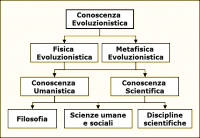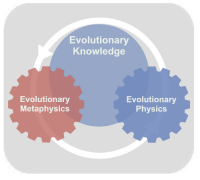Evolutionary Knowledge
Contents
Definition
Evolutionary Knowledge is a wide and comprehensive approach to the observation of the Nature, in its physical and cognitive sides, the natural and the human worlds. This approach is based on a full extension of the evolutionary theory and a critical review of the constructivist thought. It is knowledge of Reality and its manifestation, the Universe in evolution.
Common definition
In the common meaning, knowledge is the awareness and understanding of facts, truths or information obtained through experience or learning (a posteriori), or through introspection (a priori). Knowledge is self-consciousness of the possession of information related to each other, which, taken individually, have a lower value and utility. The knowledge is, therefore, a process, a path of construction, the organized collection of information on Reality. (Link to Wikipedia page: Evolutionary_epistemology).
Description
According to this approach, Knowledge is, therefore, to be considered as doubly oriented in an evolutionary sense, by object and by nature. The object is, in fact, represented by the Universe, by the Reality in evolution, in its fundamental characteristic of constant mutation. Its nature is inherently evolutive, because Knowledge is embodied in a never-ending process of construction, in which ideas, models and representations of the world cooperate and compete to create a more accurate view of a Reality in constant transformation. The same knowledge, therefore, is necessarily in constant evolution toward ever deeper levels of understanding and description of increasing complexity.
The Evolutionary Knowledge Project was born thus from the recognition, coming from the observation of the natural and human world, of the need to extend the evolutionary approach to all the areas of research and of knowledge building. It is the desire to achieve a unity of representation and integration of the areas of investigation, which leads us to seek a unified structure of thought and build a integrated set of cognitive tools, that can facilitate real progress in understanding the world as an evolving whole. The development of new concepts, new theories, and, at the same time, the recovery of the precious cultural heritage of humanity, can produce decisive synergistic effects in the path towards a less dogmatic and fragmented knowledge.
The evolutionary thinking, which, as part of the development of western science arose from the observation of nature, was already present in various forms and in various stages of development in many cultures, in many of the paths of knowledge of ancient peoples in the East as in the West. The Evolutionary Knowledge fits, then, in this vast cultural heritage, humanistic and scientific, to develop and promote an evolutionary and constructivist unified view of the formation of reality at all levels of complexity.
An initiative aimed to regain the unified vision of knowledge, fragmented during the evolution of human culture, which is necessary to overcome the difficulties of understanding and communication between these two worlds, that sometimes appear so far and irreconcilable. Distance that prevents science to achieve a fuller and deeper understanding of the physical universe, overcoming the limitations of existing theories, and that, at the same time, prevents the humanities, religion, esoteric to get rid of those elements of superstition and fanciful, that make it unacceptable to many and is easily attacked by those who seek to deny the existence of an "immaterial", "spiritual" Reality, that animates the Universe. It is, therefore, to achieve a single view that can explain Reality as it is, overcoming the limitations of pure reason, focused on the matter, and recovering, with a careful analysis and selection, the spiritualist conceptions that for millennia suggest deep reflections on the formation and existence of Reality.
Resources
- Presentazione Progetto Conoscenza Evoluzionistica - Paolo Scaranari - 3/11/2010
- Il Valore della Conoscenza - Paolo Scaranari - Articolo del 14/07/2007
See Also
- Evolutionary Knowledge System
- Evolutionary Physics
- Evolutionary Metaphysics
- Evolutionary Meta-metaphysics
- Process of Formation of Reality
- TFNR - 11. A new framework
- TFNR - 11.1 In Summary
- TFNR - 11.1.2 Hypothesis of formalization in Evolutionary Physics
Classification
- Topic id: t_ev_knowledge
- Belongs to the class: Research Areas
- Has as instances:
- Belongs to the groups:
- Semantic Map: ekm|map=m_ev_knowledge&topic=t_ev_knowledge
- Semantic Map Test Version: ekmt|map=m_ev_knowledge&topic=t_ev_knowledge

